Summary:
-
Commander’s intent and end state are given by leaders, so their team understands the purpose and outcome intended.
-
Armed with this information, a team can make decisions in a dynamic environment without needing leadership involvement.
-
Their decisions will be made with the knowledge of whether their original plan is out the window. They just need to work towards meeting the intent and end state that they received from their leader.
WAR
The commander’s intent and end state are important concepts in military leadership. Many objectives were lost because these concepts were not understood.
Let’s start with the definitions.
Commander’s intent:
-
- Commander – a person in authority
- Intention – an aim or plan.
When they are combined, it results in “a person of authority’s aim.” The commander’s intent is the leader’s desired outcome.
End state:
-
- End – come or bring to a final point; finish.
- State – the particular condition that someone or something is in at a specific time.
When they are combined, the result is “the final condition of someone or something at a specific time.” The end state is the vision for the outcome.
The best official definition of these concepts can be found in an Army publication:
“The commander’s intent succinctly describes what constitutes success for the operation. It includes the operation’s purpose, key tasks, and the conditions that define the end state. It links the mission, concept of operations, and tasks to subordinate units. A clear commander’s intent facilitates a shared understanding and focuses on the overall conditions that represent mission accomplishment. During execution, the commander’s intent spurs disciplined initiative” (ADRP 5-0, pg 2-19)
A clear commander’s intent and end state will empower a team to make decisions. They will be confident in their decisions because they will understand the purpose and goal behind them. This will remove the need to confirm every decision with leadership.
Examples of Commander’s Intent
The best way to explain the impact of a commander’s intent is through examples.
Example 1:
-
- Friendly situation: You are a squad leader. You have three teams in your squad. Each team has four infantrymen, one corporal team leader, and three riflemen. Your squad totals 13, including yourself. You are currently located on Hill 11 (below reference).
- Enemy situation: There is a likely enemy fire team on Hill 22. The enemy fire team consists of one corporal team leader and three riflemen.
- Mission: Your mission is to destroy the enemy on Hill 22
- Commander’s Intent: None
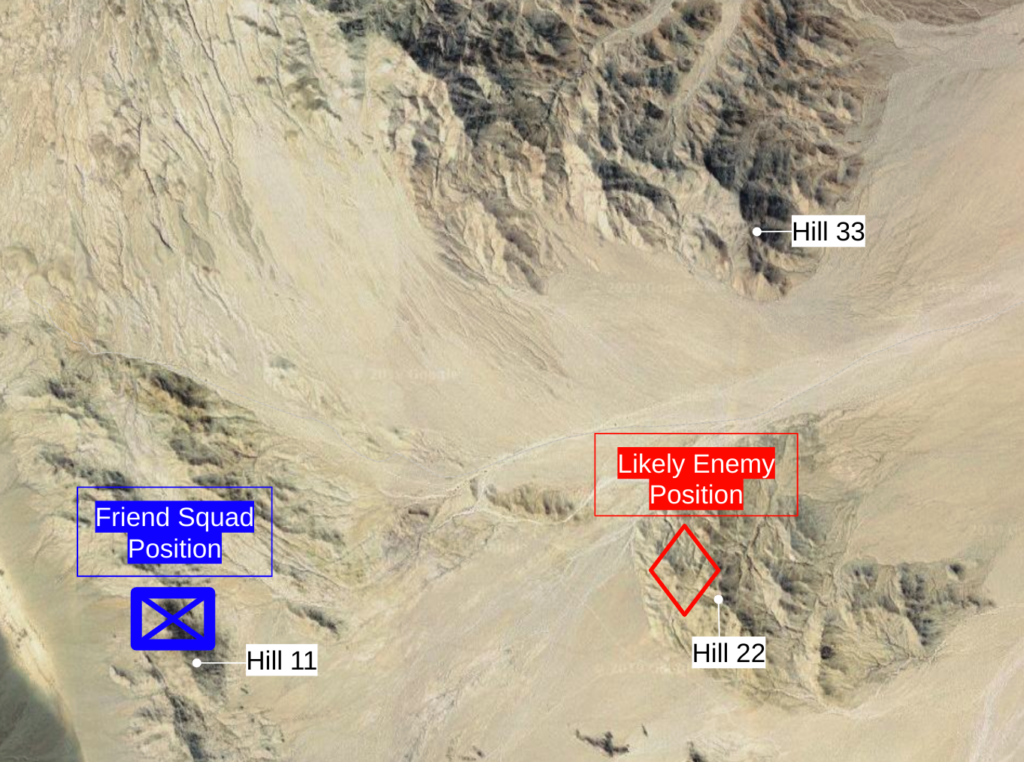
Your squad approaches Hill 22. When you get within visible distance, you see that the enemy IS NOT on Hill 22.
You can see them on Hill 33.
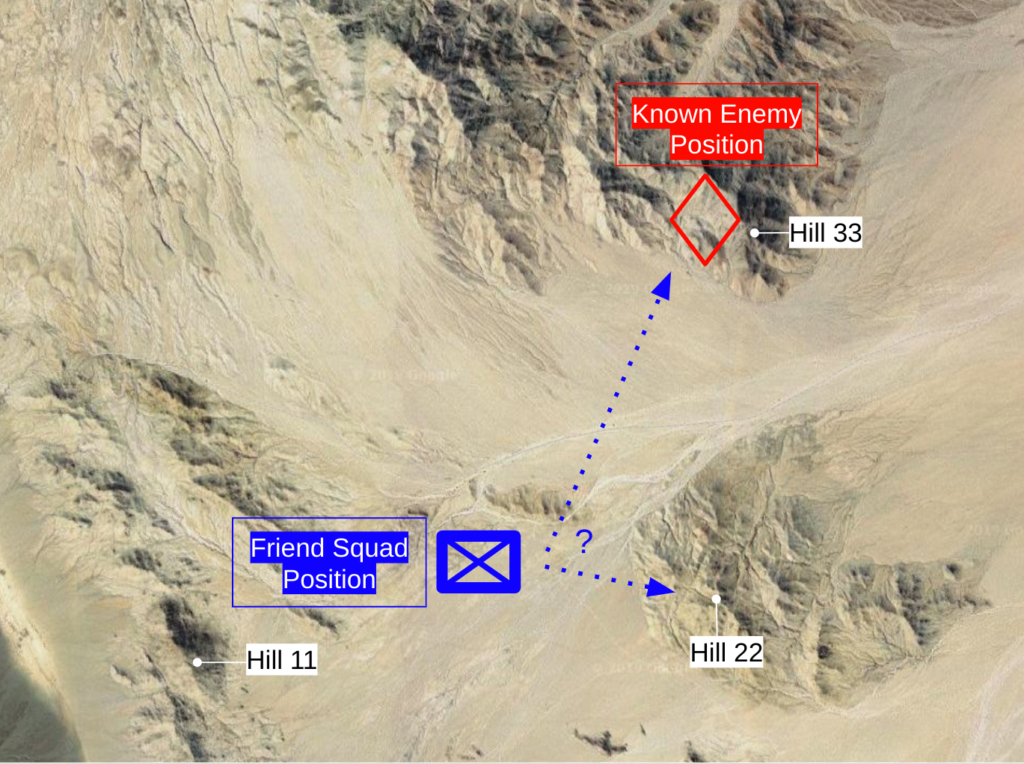
As the leader, what do you do?
Do you:
-
- Attack Hill 22 hoping that taking the hill was the intent of the mission.
- Attack Hill 33 to destroy the enemy fire team that is there.
Without the commander’s intent or end state there is no correct answer.
The commander may have wanted you to attack Hill 22 because it is key terrain in the area. In this case, you should take Hill 22.
The commander may have wanted you to attack Hill 22 to destroy the enemy. In this case, you should change headings and attack Hill 33 to destroy the enemy.
Let’s add the commander’s intent and end state to our original mission.
-
- Mission: Destroy the enemy on Hill 22.
- Commander’s Intent: In order to clear all enemy presence in the area of operation.
- End State: No enemy is able to attack friendly installations in the area of operation.
Now, you are faced with the same situation. The enemy has moved to Hill 33.
What would you do?
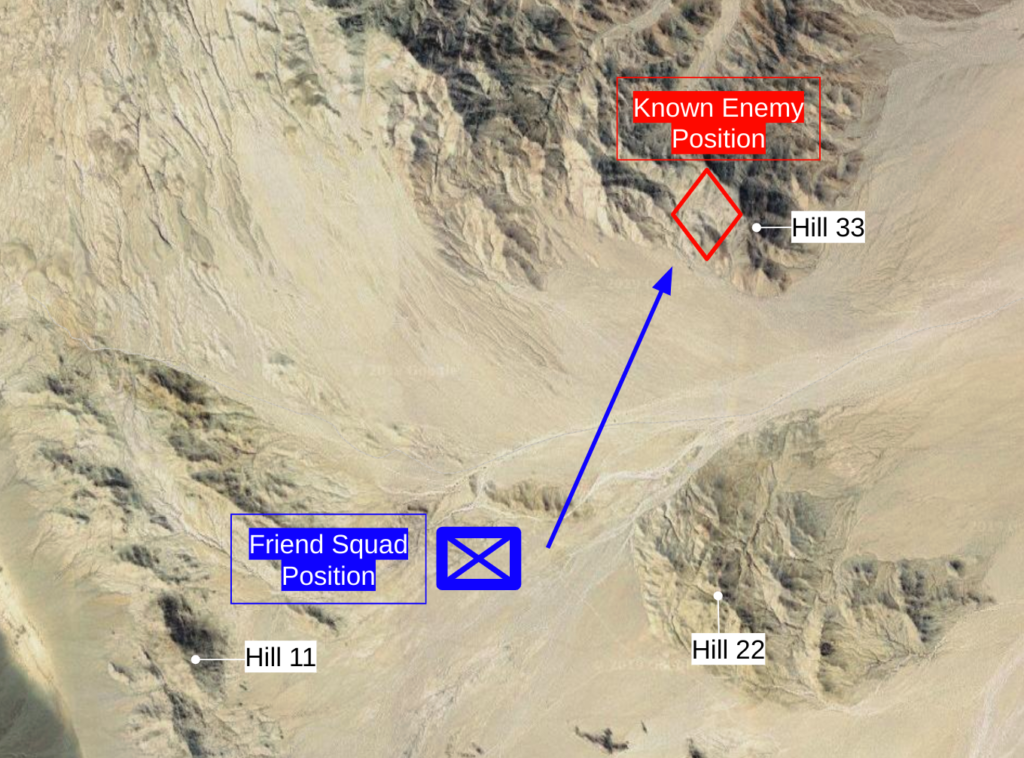
With the intent of clearing the enemy and the end state of the enemy not being able to operate, you should attack Hill 33.
Example 2:
-
- Mission: Destroy the enemy on Hill 22
- Commander’s Intent: In order to control the observation post on Hill 22
- End State: Friendly forces are able to freely use the observation post on Hill 22 to observe the surrounding area
What would you do with this intent?
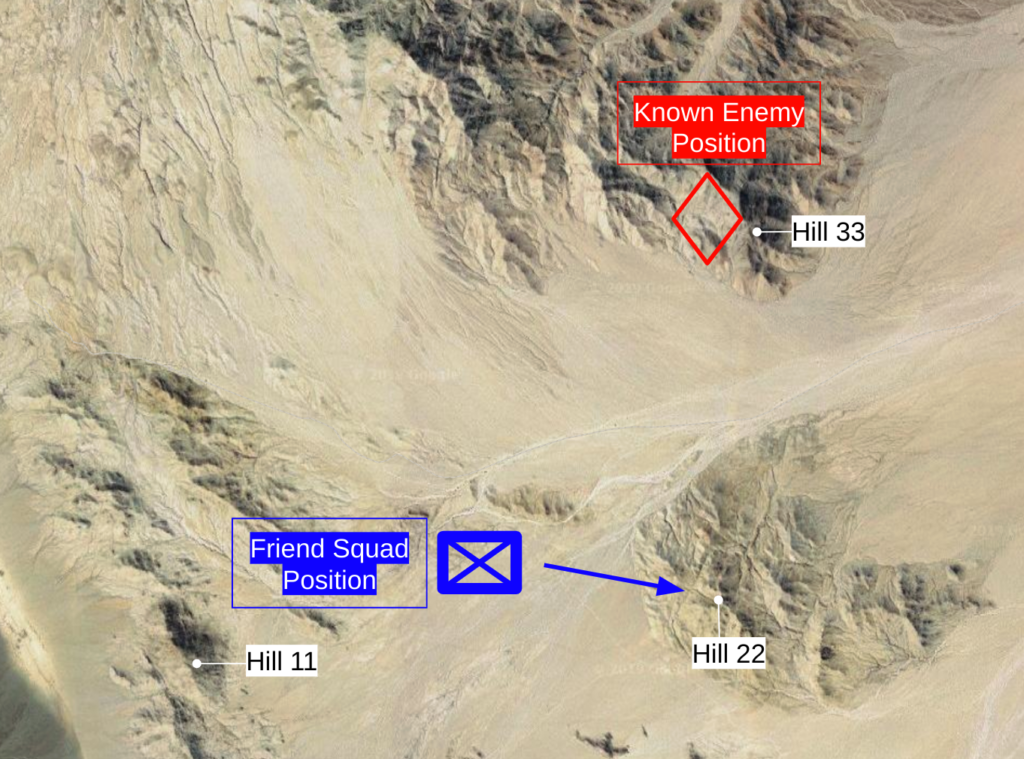
With the intent of taking the observation post, you should attack Hill 22, no matter what. This applies, even if the enemy has moved to Hill 33.
Hopefully, these examples made it clear how powerful these concepts are. Understanding the purpose and end goal of a task will change how people execute it.
Format for commander’s intent
In the Marine Corps, the commander’s intent is woven into the five-paragraph order. The five-paragraph order is the format that leaders use to communicate their plan.
In the five-paragraph order, there are a few ways that intent is given.
First, in the execution paragraph, there is a subparagraph designated specifically for the commander’s intent and end state. In their plan, the commander will literally say “my commander’s intent for this mission is to…” and then “the end state for this mission is…”
Example:
Commander’s intent – My intent for this mission is to destroy the enemy on or near Hill 22 to allow for friendly movement on Highway 5.
-
- Key tasks:
- Destroy any enemy that can affect Highway 5.
- Breach enemy obstacles on Hill 22.
- Integrate fires within the attack.
- Key tasks:
End state – The end state of this mission will be to consolidate Charlie Company Marines on Hill 22 monitoring and disrupting enemy activity around Highway 5.
The Marine Corps also expresses intent by using an “in order to” format in their mission and tasking statements.
Some examples of this format are:
- Destroy the enemy on Hill 22 in order to protect civilian movement on Highway 5.
- Suppress the enemy on Objective 1 in order to allow the 2nd squad to breach the obstacle.
Using a cue, such as “in order to,” does a few things. First, it prompts leaders to remember to put intent in their tasks. Second, it forces the leader to pause and consider the purpose of the task.
I always stop and think for a few seconds after writing the “in order to” in my tasking statements. I must make sure that I’m writing or saying the right intent within this task.
I like the use of questions to prompt me to consider the correct things.
For commander’s intent and end state some good questions are:
Commander’s intent
-
- Why are we doing this?
- How does it help the team reach its goals?
End state
-
- When it’s complete, what would it look like?
This is the commander’s intent and end state for the commander’s intent:
-
- The commander’s intent and end state allows your team to understand your reason for executing a task, in order to allow them to make accurate decisions when the environment changes.
- The end state of the commander’s intent and end state is for your team to successfully complete tasks, without leadership intervention or supervision.
BUSINESS
I understand that we’re not attacking hills in the civilian workplace. The business world is sufficiently complex to benefit from intent ( commanders are not used for business applications) and end state.
Decisions are constantly being made by everyone from the executive team to the hourly worker. These decisions are based on their understanding of their leaders’ intent and end state. Even if they have never heard of these terms, they still apply.
The senior procurement manager, merchandising managers, and engineers are all making decisions based on their understanding of CEOs, vice presidents, and directors’ intent and end state. The better they understand it, the more accurate their decisions will be. If they do not understand it, their decisions will be adversely affected.
If you asked ten different people what the intent and end state of the most important project in the company is, you would probably get ten different answers.
You should get one.
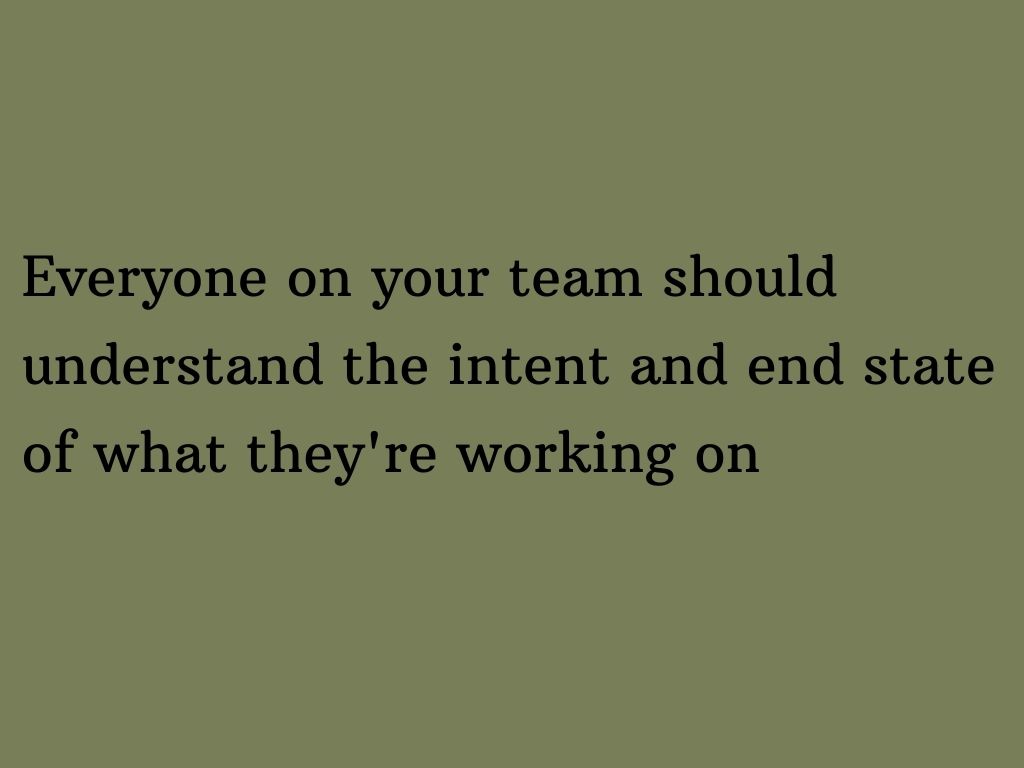
The best practice would be to provide your intent and end state for every task and meeting and ask for intent and end state from your associates.
Repetition is essential for retention.
Examples:
-
- Giving intent and end state on a project: The intent of this project is to produce the best pair of men’s running shoes between $100 – $150, with the end state of reaching a 30% market share in that segment by end of the year.
- Intent and end state of a meeting: “My intent of this meeting is to get input on the team structure for this project. The end state is to make a decision on the team, so we can move forward with the project”
- Intent and end state of a task: “Hey, Jess. I need some help processing this ticket. My intent is to get this ticket closed today or tomorrow, so I can start working on this platform again.”
- Asking for intent and end state: “Just to be clear, the intent of this spreadsheet is to compare Q1 and Q2 income statements, so our director can report it to the VP in next week’s meeting.”
Intent and end state can be used in almost any situation. They are an excellent framework for clarifying the purpose of almost any situation.
Summary:
The commander’s intent is to provide the reason for actions. Therefore, if their environment changes, they can make good decisions without further guidance. The end state is that everyone can make decisions on their own as effectively as possible.
If they receive a clear definition of the commander’s intent and end state, subordinate leaders and individual contributors will be able to make the correct decisions rapidly and without guidance in dynamic environments.
REFERENCES:
-
- “ADRP 5-0 THE OPERATIONS PROCESS.” HEADQUARTERS, DEPARTMENT OF THE ARMY. May 2012. Link
- Stouffer, Jeff and Farley, Dr. Kelly. “Command Intent: International Perspectives and Challenges”. 2008. Link
- Dempsey, Maj. Richard Dempsey and Chavous, Maj. Jonathan M. “Commander’s Intent and Concept of Operations.” MILITARY REVIEW. November-December 2013. Link

0 Comments